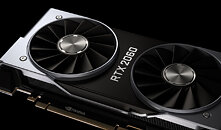Raevenlord
News Editor
- Joined
- Aug 12, 2016
- Messages
- 3,755 (1.24/day)
- Location
- Portugal
| System Name | The Ryzening |
|---|---|
| Processor | AMD Ryzen 9 5900X |
| Motherboard | MSI X570 MAG TOMAHAWK |
| Cooling | Lian Li Galahad 360mm AIO |
| Memory | 32 GB G.Skill Trident Z F4-3733 (4x 8 GB) |
| Video Card(s) | Gigabyte RTX 3070 Ti |
| Storage | Boot: Transcend MTE220S 2TB, Kintson A2000 1TB, Seagate Firewolf Pro 14 TB |
| Display(s) | Acer Nitro VG270UP (1440p 144 Hz IPS) |
| Case | Lian Li O11DX Dynamic White |
| Audio Device(s) | iFi Audio Zen DAC |
| Power Supply | Seasonic Focus+ 750 W |
| Mouse | Cooler Master Masterkeys Lite L |
| Keyboard | Cooler Master Masterkeys Lite L |
| Software | Windows 10 x64 |
The on-again, off-again relationship between NVIDIA and its Turing-based RTX 2060 graphics seems to be heading towards a new tipping point. As previously reported, NVIDIA is expected to be preparing another release cycle for its RTX 2060 graphics card - this time, paired with an as puzzling as it is gargantuan (for its shader performance) 12 GB of GDDR6 memory. Gigabyte has given us yet another tip at the card's expected launch by the end of this year or early 2022 by registering four different card models with the EEC (Eurasian Economic Commission). Gigabyte's four registered cards carry the model numbers GV-N2060OC-12GD, GV-N2060D6-12GD, GV-N2060WF2OC-12GD, and GV-N2060WF2-12GD. Do however remember that not all registered graphics cards actually make it to market.
NVIDIA's revival of the RTX 2060 towards the current market conditions speaks in volumes. While NVIDIA is producing as many 8 nm cards as it can with foundry partner Samsung, the current state of the graphics card pricing market leaves no doubts as to how successfully NVIDIA has been able to cope with both the logistics and materials constraints currently experienced by the semiconductor market. The 12 nm manufacturing process certainly has more available capacity than Samsung's 8 nm; at the same time, the RTX 2060's mining capabilities have been overtaken by graphics cards from the Ampere family, meaning that miners most likely will not look at these as viable options for mining, thus improving availability for consumers as well. If the card does keep close to its expected $300 price-point upon release, of course.


View at TechPowerUp Main Site
NVIDIA's revival of the RTX 2060 towards the current market conditions speaks in volumes. While NVIDIA is producing as many 8 nm cards as it can with foundry partner Samsung, the current state of the graphics card pricing market leaves no doubts as to how successfully NVIDIA has been able to cope with both the logistics and materials constraints currently experienced by the semiconductor market. The 12 nm manufacturing process certainly has more available capacity than Samsung's 8 nm; at the same time, the RTX 2060's mining capabilities have been overtaken by graphics cards from the Ampere family, meaning that miners most likely will not look at these as viable options for mining, thus improving availability for consumers as well. If the card does keep close to its expected $300 price-point upon release, of course.


View at TechPowerUp Main Site




